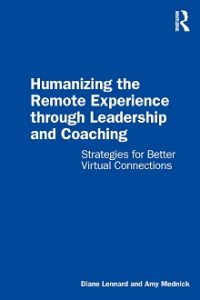On Writing Humanizing the Remote Experience through Leadership and Coaching
The book, Humanizing the Remote Experience through Leadership and Coaching, is the product of a teacher without her classroom and a psychiatrist without her couch.
 We were mid-way through a global pandemic and several months into a total lockdown when we decided to write this book. Diane, a communication coach and university professor, was coaching clients remotely and teaching graduate students online. After years of avoiding teaching and coaching online, Diane was doing all her work remotely and managing the extra cognitive load that came with it. Amy, a psychiatrist, was treating her patients by telemedicine and teaching psychiatric trainees remotely. She was reshaping her private practice around an online model and trying to figure out how to keep her patients feeling connected when she could no longer pass them a box of tissues for comfort.
We were mid-way through a global pandemic and several months into a total lockdown when we decided to write this book. Diane, a communication coach and university professor, was coaching clients remotely and teaching graduate students online. After years of avoiding teaching and coaching online, Diane was doing all her work remotely and managing the extra cognitive load that came with it. Amy, a psychiatrist, was treating her patients by telemedicine and teaching psychiatric trainees remotely. She was reshaping her private practice around an online model and trying to figure out how to keep her patients feeling connected when she could no longer pass them a box of tissues for comfort.
Our remote work experiences required a significant shift in how we engaged with other people. We were curious about this shift and wanted to make sense of an intriguing paradox that was playing out all around us in real time: the technology people created and use to connect with others was leaving us feeling less connected.
We set out on a journey to better understand the human side of the remote experience. It seemed essential to approach this through a framework of basic human needs, including safety and comfort, understanding others, and belonging to a group. That led us to explore the workings of the human brain most affected when these innate needs were not met during remote interactions, such as attention, engagement, and human connection.
Co-writing Humanizing the Remote Experience was a remote experience in itself. During our remote work sessions, we discussed a wide range of relevant research studies and examined our own remote experiences. We also interviewed many of our colleagues, clients, students, patients, friends, and family members to learn about their challenges of working, learning, and socializing remotely. Then, we gathered information on strategies for adjusting to the remote experience that were supported by scientific research. Our fascination with the data from research studies and first-person lived experiences motivated us to dig deeper in our search for a more human-centered approach to the remote experience.
Together, we explored the remote experience from multiple perspectives, including neurobiological, educational, psychological, organizational, and philosophical. After considering the digital and human sides of the paradox, our starting point for writing Chapter 1 was the scientific exploration of attention processes. From her work as a psychiatrist, Amy knew that focused attention is vital to optimal functioning. Effective communication and group dynamics were important to Diane as an educator and communication coach whose work centers around establishing mutual engagement, expressing clear messages, and strengthening social connections. Both of us continually questioned aspects of the remote experience and searched the literature across a variety of disciplines to fill in the gaps during the year-long writing process.
In Humanizing the Remote Experience, we examine the key challenges people encounter in their remote experiences when the deep-seated human need to connect with others is not met. We also offer perspectives on how leadership and coaching can be used to raise engagement, strengthen connections, and foster a sense of well-being in our increasingly remote lives.
Part One of Humanizing the Remote Experience introduces the paradox that the technology we use to connect with others can leave us feeling less connected. Our intention is to provide readers with a general understanding of how technology serves our efficiency needs but doesn’t necessarily take our well-being or innate need for social connection into account. In the introduction, we give an overview of how our brains are wired for social connection so that we can better understand the human side of the paradox. We then explore the benefits of technology on the digital side of the paradox. Three chapters follow. Chapter 1 looks at how restricted movement in a flat, two-dimensional virtual space challenges our ability to fully express ourselves. Chapter 2 examines how significant parts of messages get lost or distorted in virtual settings, moving people away from having satisfying, meaningful social connections. Chapter 3 addresses how people feel in a virtual group, and the challenges of participating fully, feeling understood, and being in touch with the emotional state of others.
In Part Two of Humanizing the Remote Experience, we demystify the human need to connect and provide science-based strategies that can improve remote experiences. Chapter 4 explains the critical importance of intercepting the stress response early and how to take control of it to protect your health and wellness in different facets of life. Chapter 5 describes ways to manage your energy to promote engagement during remote interactions, and suggests strategies for avoiding cognitive overload and preventing burnout. Chapter 6 discusses prioritizing people, communicating to connect, and cultivating a sense of purpose and meaning. Chapter 7 encourages readers to make choices and take actions that will result in a more human-centered approach to the remote experience that mitigates the challenges of interacting through digital technology. This part of the book highlights what we believe is possible when people focus not only on the quantity and efficiency of our interactions, but also the quality and depth of our human connections.
After spending a year thinking about the challenges of virtual interactions and ways to mitigate them, we know there is still more to learn. While that learning continues, one thing is clear to us: people can stay connected with others and strengthen that connection, even when apart. Figuring out what strategies, practices, and techniques work best for each of us and each of our lifestyles is an ongoing learning process.
BUY THE BOOK HERE
—
 DIANE LENNARD is a professor of management communication at NYU Stern School of Business and a communication coach for executives, teams, educators, and professionals.She has taught courses on strategic team communication and engaging audiences and served as the Director of Langone Education and as a faculty development consultant for Stern’s Center for Innovation in Teaching and Learning. She is the founder of Lennard & Company, a firm that provides communication coaching to educational institutions, corporations, and individuals who want to expand their communication abilities in diverse work settings. A leading expert in workplace communication, she is the author of Coaching Models: A Cultural Perspective, Strategic Communication at Work: The Impact Paradigm, and Humanizing the Remote Experience through Leadership and Coaching: Strategies for Better Virtual Connections (Routledge; September 2, 2022). Learn more at www.HTRE-Book.com.
DIANE LENNARD is a professor of management communication at NYU Stern School of Business and a communication coach for executives, teams, educators, and professionals.She has taught courses on strategic team communication and engaging audiences and served as the Director of Langone Education and as a faculty development consultant for Stern’s Center for Innovation in Teaching and Learning. She is the founder of Lennard & Company, a firm that provides communication coaching to educational institutions, corporations, and individuals who want to expand their communication abilities in diverse work settings. A leading expert in workplace communication, she is the author of Coaching Models: A Cultural Perspective, Strategic Communication at Work: The Impact Paradigm, and Humanizing the Remote Experience through Leadership and Coaching: Strategies for Better Virtual Connections (Routledge; September 2, 2022). Learn more at www.HTRE-Book.com.
 AMY MEDNICK is a psychiatrist working in her own private practice. She received her medical degree with Distinction in Research from Albert Einstein College of Medicine and a Bachelor of Science in Brain & Cognitive Sciences from MIT. She specializes in the overlap between the humanities and neuroscience and leads a lecture series for psychiatric residents in training, social workers, and psychology trainees.She’s been involved in both brain research and linguistic research and has authored articles in Clinical Psychiatry News. Her new book is Humanizing the Remote Experience through Leadership and Coaching: Strategies for Better Virtual Connections (Routledge; September 2, 2022). Learn more at www.HTRE-Book.com.
AMY MEDNICK is a psychiatrist working in her own private practice. She received her medical degree with Distinction in Research from Albert Einstein College of Medicine and a Bachelor of Science in Brain & Cognitive Sciences from MIT. She specializes in the overlap between the humanities and neuroscience and leads a lecture series for psychiatric residents in training, social workers, and psychology trainees.She’s been involved in both brain research and linguistic research and has authored articles in Clinical Psychiatry News. Her new book is Humanizing the Remote Experience through Leadership and Coaching: Strategies for Better Virtual Connections (Routledge; September 2, 2022). Learn more at www.HTRE-Book.com.
Category: On Writing
























